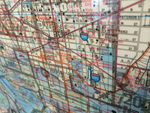We are approaching the summer high season, when tens of millions of Americans head for vacation to the mountains and lakes within an hour or two of their homes. But a slightly smaller number opts for longer-range travel--either to the coastal areas as many as three and four hours by air, or overseas on flights requiring from seven to ten hours.
Where is that latter group going this summer? I have no crystal ball, but I do know the titles of Frommer's travel guides that are selling best in the bookstores. And though these guidebook sales may be influenced by considerations other than the popularity of the destinations they cover--some books, for instance, gain a reputation over the years and thus enjoy heavy sales to places that aren't as high up on the list of favorites as you'd imagine. With that warning, here's what the guidebook sales tell us about the fairly remote, long-distance places to which large hordes of Americans will be traveling this summer.
New York City comes first, as surprising as that may seem. But that's a conclusion that's further confirmed by the actual, unchallenged statistics. In recent years, the Big Apple has been visited by more than fifty million tourists each year, far outdistancing its rivals for the tourist dollar. Though Orlando and Las Vegas each attract more than 40 million visitors a year, they nevertheless lag far behind New York.
Just behind Orlando and Las Vegas in guidebook sales--and thus probably in actual popularity as well--is the nation's capital, Washington, D.C. Numerous American parents believe it is important for their children to visit that seat of government and its many attractions.
In terms of other long-distance destinations in America, San Francisco fights it out with New Orleans. The latter city seems finally to have overcome the damaging effects of Hurricane Katrina, and is once again chosen by substantial numbers of tourists eager to taste the sometimes-outrageous pleasures of Fat City. Both such places are given a hard fight by our National Parks of the American West, especially Yellowstone, Yosemite and the Grand Canyon, as to which tons of guidebooks are purchased.
As for those international destinations directly south of the U.S., Costa Rica is currently the unchallenged leader in guidebook sales (if not in actual visitors); Americans are flocking there in increasing numbers, and they are taking pains to equip themselves with travel information for the stay. Though the Dominican Republic, Jamaica and Puerto Rico probably outclass Costa Rica in actual tourism, their guidebook sales are paltry compared with Costa Rica.
Trans-Atlantic, the undoubted leaders are London, Paris and Rome--probably in that order. But amazingly enough, the fourth European position doesn't belong to Prague or Barcelona or Berlin--but to Ireland, much to my own surprise. Tourists are told by their friends that the best way to visit the Emerald Isle is on a totally unplanned, self-drive auto trip, simply wandering at random. And yet when they undertake the actual trip, they take pains to equip themselves with a guidebook advocating a meticulous, carefully chosen and planned itinerary by car, removing much of the spontaneity from these self-drive adventures. We're about to go to press (my daughter and myself) for additional copies of our own guidebook to Ireland, so heavy is the demand for it.
So there you have it (with apologies to Hawaii, Croatia, Vancouver and Victoria, Spain, and other runners-up). In our profession (publication of the Frommer travel guides), you pay attention primarily to the choices that Americans make in the bookstores when they plan for a summer of travel.





